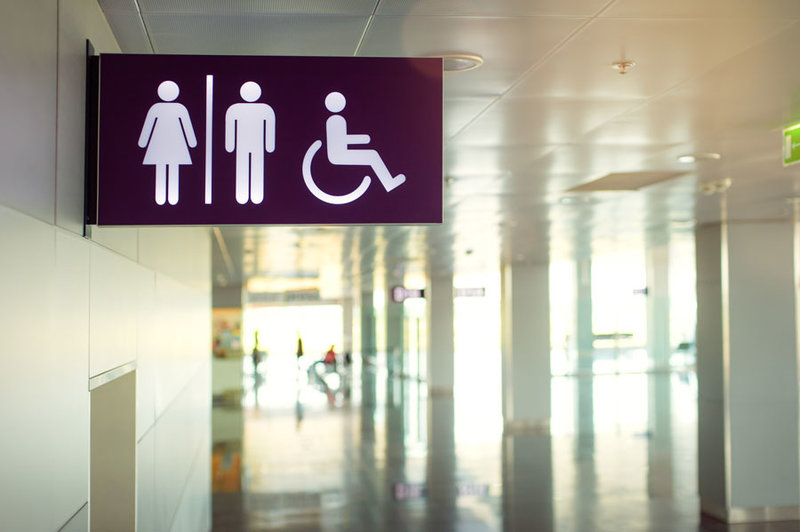Passenger Services
Smart environments:
how airports use tech to welcome special needs passengers
Worldwide, airports are constantly adapting to accommodate passengers with a range of hidden disabilities. From smart glasses for blind travellers to sensory rooms for passengers with autism, Eva Grey explores the resourceful initiatives helping make air travel a more manageable experience
T
he accessibility of air travel for people with physical disabilities has been slowly improving since 1986, when the Air Carrier Access Act was signed into law and eventually led to the implementation of regulations designed to ensure equal access in air travel.
Over the past few years, airlines and airports have shown improved general awareness of the so-called “hidden” disabilities, such as autism, dementia, hearing problems, low vision and blindness.
In the UK, regulatory body Civil Aviation Authority (CAA) published guidance for airports in 2016, setting out how they should improve journeys for those with these conditions. Key recommendations included training for airport staff, publishing clear and detailed information ahead of travel and arranging quiet areas to ensure the airport environment is less stressful and disorientating.
A year later, CAA’s second annual Airport Accessibility report published some heartening findings: the number of disabled people and those with mobility restrictions using air travel had increased to reach three million in 2016. Judging the quality of support and guidance received, passenger satisfaction levels averaged at 80%. Just four airports – East Midlands, Exeter, Heathrow and Manchester – scored poorly, and have since started their own individual improvement plans.
Elsewhere, the Open Doors Organization (ODO) found that adults with disabilities spend around $17.3bn annually on their own travel, up from $13.6bn in 2002, but warned that air travel is one of the key areas where “many barriers to access still remain”.
Now, specialist technology is increasingly used by operators and airports to support, guide and offer the much needed independence and peace of mind to travellers with hidden disabilities.
Image courtesy: Something / Example.com
Dementia-friendly airports
Two years ago, London’s Heathrow became the world’s first dementia-friendly airport, when it launched a training programme designed to familiarise all of its 76,000 staff with the syndrome. Worldwide, around 50 million people have dementia, and there are nearly 10 million new cases every year, according to the World Health Organization.
Working with Omniserv, which provides assistance for passengers with special requirements, Heathrow organised training for its entire frontline staff based on Alzheimer's Society courses. A particular focus fell on the frontline Special Assistance team, who regularly interact with passengers affected by dementia. It has also worked with security to ease any occurring anxiety, as well as providing quiet designated lounges in the terminals.

Image courtesy:
Following CAA’s poor rating of its disability support services – which flagged pitfalls such as unacceptable levels of customer service and instances where passengers had not been treated with dignity and respect – Heathrow rolled out a new plan to overhaul its services, as it entered a new £23m contract with Omniserv. The new measures included lanyards for passengers with hidden disabilities, specialised signage to flag special assistance areas, and an on-demand service for British Sign Language translators.
The lanyard initiative was pioneered by Gatwick in 2016, where they were introduced as a completely voluntary and discreet way for passengers and their families to attract the attention of airport staff and suggest they might need assistance. The project, along with other accompanying measures, earned Gatwick the Alzheimer's Society's Dementia Friendly Innovation award in 2016.
On the other side of the globe, Brisbane Airport followed suit and in June last year, it became Australia’s first dementia-friendly airport. As part of a long-term collaboration with a specialised centre, Brisbane published a step-by-step guide, which takes users through the different airport zones, outlining what to expect in the bag screening area, duty free regulations, customs, quarantine, transfers and immigration.
Eero Knuutila is Head of Service Development at Helsinki Airport.
Image courtesy: Helsinki Airport
Heathrow organised training for its entire frontline staff based on Alzheimer's Society courses
A helping hand for autistic passengers
For people on the autism spectrum, air travel and in particular the hectic airport environment can easily become overwhelming and unusually stressful.
To ease their anxiety, Ireland’s Shannon Airport became the first European airport to open a sensory room in its departure lounge, dedicated to travellers with neurodevelopmental challenges, including autism. The space features facilities such as an aquatic bubble tube, an undulated wavy wall, colour changing LEDs, and a wheel projector. It is specifically designed to be a soothing place for both children and adults alike.
Its opening came at the end of a year-long effort from Shannon to improve the airport experience for anyone who might be struggling, and those who feel they need support can wear a cap or wristband to be easily identifiable to staff. The airport also organises pre-arranged tours so that passengers can familiarise themselves with their surroundings ahead of their travel day.
In October last year, Canada’s Toronto Pearson decided to employ state-of-the-art technology in its pursuit for accessibility. By partnering with tech developers Magnusmode, the airport now offers a free app that works as a digital how-to guide for people with cognitive special needs.

Image courtesy:
By using MagnusCards, Pearson visitors can download up to 10 different Card Decks, which combine learning with game design in order to prepare people for new situations. According to the developers, the app is “ideal for everyone who likes structured guidance, including those living with autism, ADHD, Asperger's, Down’s syndrome, dementia and other cognitive special needs.”
Often, people on the autism spectrum struggle with certain types of social interaction and might respond negatively to any kind of touching or invasion of their personal space. In recognition of this, India’s Delhi Airport announced that it would start training its security personnel to act friendly towards autistic passengers, who are now directed through a separate security queue.
The announcement was made after a 15-year-old boy became violent and attacked security guards at a Mumbai airport. It later transpired that he was autistic and disliked being touched by strangers.
Indian NGO Action for Autism is working with the airport to assist personnel in correctly identifying and handling special needs passengers.
The airport now offers a free app that works as a digital how-to guide for people with cognitive special needs
Improved guidance for blind and low-vision travellers
Those passengers with vision impairments can now use smart-glasses when flying from Memphis International Airport (MEM).
Thanks to a partnership with technology company Aira in October last year, passengers will be able to either use wearable smart glasses or their own smartphone camera to share live views of their surroundings as they are guided by an agent via the company’s app.
“With a live view of surroundings, crowd flow, signage or other objects from the traveller’s perspective, Aira agents deliver a real-time narrative to the traveller using an augmented reality dashboard,” a press release reads.
The service, freely available for MEM visitors, not only enables navigation through the airport, but also provides assistance with other tasks such as flight information, locating and identifying baggage and arranging transportation.

Image courtesy:
As of January this year, Minneapolis St. Paul International Airport also joined forces with the company and started using the app.
India’s Visakhapatnam Airport has taken a different approach to guiding passengers: tactile paving.
The 75m-long pavement has a built-in pattern that indicates any obstacles and turns coming ahead. Ahead of opening, the path was tested with local schools for the blind, and local media reported that similar paving styles will be rolled out at railway stations, bus stops and pedestrian footpaths across the city of Visakhapatnam.
And, in a more light-hearted approach to tactile surroundings, Pune International Airport, located in western India, put on display the art of painter Chintamani Hasabnis, full of outlines and paragraphs written in Braille. Pune became the world’s first airport to display artwork aimed at the visually impaired. In interviews with the local press, Hasabnis said that the airport felt like “the right place” to display his work.
The 75m-long pavement has a built-in pattern that indicates any obstacles and turns coming ahead